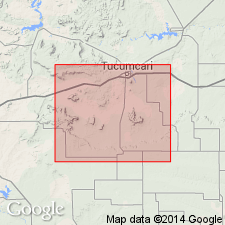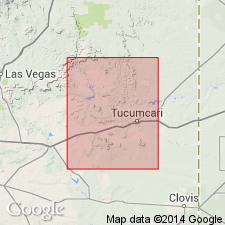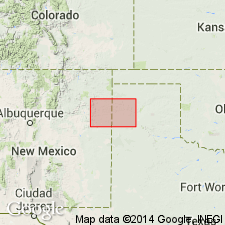
- Usage in publication:
-
- Tucumcari shale member*
- Modifications:
-
- Revised
- AAPG geologic province:
-
- Palo Duro basin
Summary:
Assigned as the lower member of Purgatoire formation. Upper contact revised. Name applied only to rocks considered to be the lower part of the Tucumcari that are composed of gray shale and buff calcareous sandstone that has argillaceous limestone nodules, and a thin basal sandstone. The restricted Tucumcari is very fossiliferous. The fauna (listed) is of Kiamichi and Duck Creek age. The restricted Tucumcari unconformably overlies Chinle, Wingate? or Morrison formation. The overlying white to buff cross-bedded, medium- or coarse-grained sandstone formerly considered to be the upper part of the Tucumcari is reassigned to the Mesa Rica sandstone member (first used), middle member of the Purgatoire. Geologic map; cross sections. Early Cretaceous age. Report area lies in the Palo Duro basin of eastern NM.
Source: GNU records (USGS DDS-6; Denver GNULEX).

- Usage in publication:
-
- Tucumcari shale*
- Modifications:
-
- Revised
- AAPG geologic province:
-
- Palo Duro basin
- Sierra Grande uplift
Summary:
Raised in stratigraphic rank from Tucumcari shale member, basal member of Purgatoire formation to Tucumcari shale. Term Purgatoire abandoned [should read "areally restricted"] from use in Guadalupe, Harding, San Miguel, and Quay Cos, northeast NM in the Palo Duro basin and on the Sierra Grande uplift. Overlies Morrison formation; underlies Mesa Rica sandstone (formerly a member of Purgatoire. Ranges from 0-60 ft thick. Includes in addition to shale, a 1-2 in bed of quartz and quartzite pebbles and thin sandstone beds. Contains a marine fauna, probably Kiamichi, latest Fredericksburg, or Early Cretaceous age.
Source: GNU records (USGS DDS-6; Denver GNULEX).

- Usage in publication:
-
- Tucumcari Shale
- Modifications:
-
- Areal extent
- Overview
- Dominant lithology:
-
- Shale
- Limestone
- Sandstone
- Conglomerate
- AAPG geologic province:
-
- Sierra Grande uplift
- Palo Duro basin
Summary:
Is Lower Cretaceous unit [unranked] that comprises lower part of Purgatoire Formation as mapped with Dakota Sandstone, undivided, in southern Harding and adjacent southeastern Union Cos, NM (Sierra Grande uplift) and in eastern San Miguel and northwest Quay Cos, NM (Palo Duro basin). Dakota and Purgatoire, undivided, not mapped as far east as TX Panhandle. Tucumcari described from top down as shale, limestone, sandstone, and conglomerate--shale, black contains both Kiamichi and Duck Creek faunas; limestone, argillaceous; basal sand and conglomerate unconformably rest on Morrison Formation (Upper Jurassic), thickness up to 20 ft; thickness of Tucumcari Shale up to 60 ft.
Source: GNU records (USGS DDS-6; Denver GNULEX).
For more information, please contact Nancy Stamm, Geologic Names Committee Secretary.
Asterisk (*) indicates published by U.S. Geological Survey authors.
"No current usage" (†) implies that a name has been abandoned or has fallen into disuse. Former usage and, if known, replacement name given in parentheses ( ).
Slash (/) indicates name conflicts with nomenclatural guidelines (CSN, 1933; ACSN, 1961, 1970; NACSN, 1983, 2005, 2021). May be explained within brackets ([ ]).

